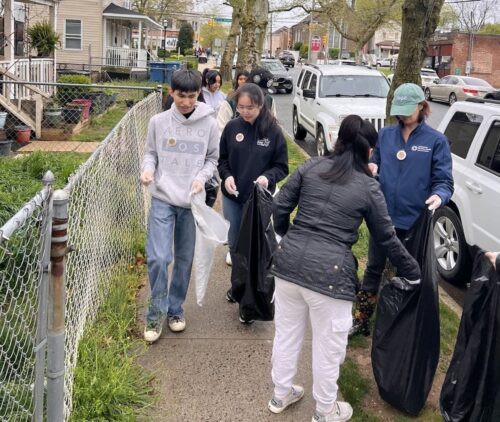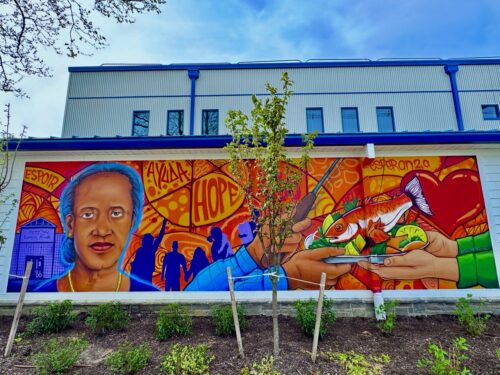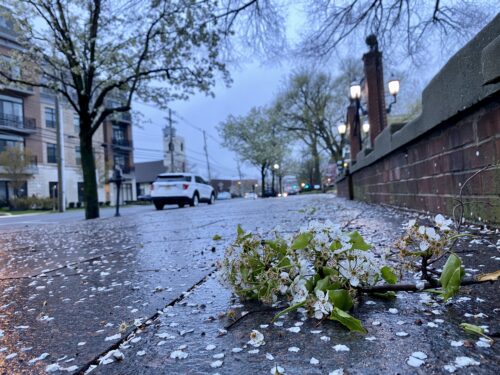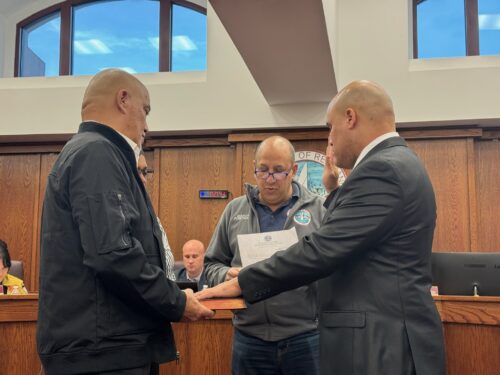 T. Thomas Fortune, below, and the cultural center dedicated to him in his onetime Red Bank home, above. (Above photo by John T. Ward. Click to enlarge.)
T. Thomas Fortune, below, and the cultural center dedicated to him in his onetime Red Bank home, above. (Above photo by John T. Ward. Click to enlarge.)
With an exhibit examining the history of America’s Black press opening October 28 at Red Bank’s T. Thomas Fortune Cultural Center, redbankgreen presents this feature story, written for CivicStory, about the center’s namesake.
By DEBORAH YAFFE
When the Black newspaper editor and civil-rights activist T. Thomas Fortune moved to Red Bank in the summer of 1901, his arrival was front-page news. “Mr. Fortune is one of the most noted colored men of the country,” the Red Bank Register reported.
But a century later, the elegant Red Bank home that Fortune’s family called Maple Hall stood vandalized and derelict, its brick foundation crumbling, its windows boarded up. Still, the once-grand old place caught Gilda Rogers’ eye whenever she passed by. “That home probably was something really special in its heyday,” she would think.
She wasn’t wrong.
 Gilda Rogers, center, with Roger Mumford in 2016. Below, the Fortune House mid-reconstruction a year later. (Photos by John T. Ward. Click to enlarge.)
Gilda Rogers, center, with Roger Mumford in 2016. Below, the Fortune House mid-reconstruction a year later. (Photos by John T. Ward. Click to enlarge.)
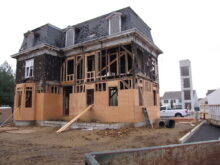 Today, Fortune’s name is largely unfamiliar outside of academic circles – except, perhaps, to viewers of HBO’s series “The Gilded Age,” which includes Fortune among its mix of fictional and real-life characters. But in his time, he was a brilliant and controversial figure: the editor of the country’s most admired Black newspaper; the founder of a national civil rights organization that pre-dated the NAACP; and a close associate of such leading Black activists as W.E.B. Du Bois, Booker T. Washington and Ida B. Wells.
Today, Fortune’s name is largely unfamiliar outside of academic circles – except, perhaps, to viewers of HBO’s series “The Gilded Age,” which includes Fortune among its mix of fictional and real-life characters. But in his time, he was a brilliant and controversial figure: the editor of the country’s most admired Black newspaper; the founder of a national civil rights organization that pre-dated the NAACP; and a close associate of such leading Black activists as W.E.B. Du Bois, Booker T. Washington and Ida B. Wells.
Although Fortune’s one-time home in Red Bank was named a National Historic Landmark in the 1970s, by 2014 it teetered on the brink of demolition. But four years ago, after a meticulously detailed restoration, Maple Hall reopened as the nonprofit T. Thomas Fortune Cultural Center, dedicated to advancing Fortune’s social justice agenda.
Enabling the joyful ribbon-cutting in May 2019 was a decade of tireless campaigning by a multiracial, grassroots volunteer coalition whose members – with Rogers a leading voice – leveraged an innovative public-private partnership to preserve a piece of Black history. Current programming aims to continue that work: On October 28, the day before the premiere of season two of “The Gilded Age,” the cultural center will open the first installment of a permanent exhibit on Fortune and his context, titled “The Black Press: Stewards of Democracy.”
“All over the country, there are really important African-American artists and intellectuals who have virtually no space dedicated to their memory in the places where they lived,” says Seth Moglen, a Lehigh University professor of English, American studies and Africana studies, who produced a modern edition of Fortune’s 1884 book “Black and White: Land, Labor, and Politics in the South.” “The work of this community – to hold on to Fortune’s home, to keep it from being knocked down, and to turn it into a space for education and the arts and social justice in Fortune’s honor – is an extraordinarily important initiative.”
Born into slavery in Florida in 1856, Timothy Thomas Fortune lived through the promise and betrayal of post-Civil War America. By his teenage years, Ku Klux Klan terror targeting his politically active father forced his family out of their Panhandle home. In his 20s, Fortune moved to New York City and soon made a name for himself as editor of the weekly paper eventually known as The New York Age. Largely self-educated, Fortune was a gifted writer whose fiery editorials highlighted the suppression of Black voting rights, condemned lynching and demanded civil rights for all Americans.
“He was an uncompromising figure,” says Rogers, a 32-year Red Bank resident who is now executive director of the T. Thomas Fortune Cultural Center. “We hear that term ‘speak truth to power.’ He did it.”
Fortune gave the future NAACP founder Du Bois his first writing job; hired anti-lynching crusader Wells after a white mob destroyed her Memphis newspaper office; and served as a ghostwriter and sometime hatchet man for the prominent Black leader Booker T. Washington, who secretly helped fund Fortune’s always-struggling newspaper. Washington paid at least one visit to Red Bank, then considered a country retreat; Fortune’s family lived on the segregated town’s west side, home to the Black residents who, Census figures show, made up roughly 11 percent of the population at the time.
Fortune used Maple Hall – on what was then called Beech Street, and is now Drs. James Parker Boulevard – as a base for journalism, activism and family life. His wife, Carrie, was a founding member of St. Thomas Episcopal Church; their son Frederick graduated from Red Bank High School in 1910; and friends and professional associates came for long visits.
Fortune was a tireless networker, says Walter D. Greason, a professor of history at Minnesota’s Macalester College and a board member of the T. Thomas Fortune Foundation, which administers the cultural center. Fortune’s work eventually enabled the creation of powerful civil rights institutions, although those he helped found in the 1890s – the National Afro-American League and its successor, the National Afro-American Council – did not endure. “There are these communities of people pooling resources and building institutions,” Greason says. “He’s constantly pushing his physical limits in order to connect people, so that they can reach further with their ideas.”
But Fortune’s life – personal, professional and political – was complicated and emotionally draining. Money was always tight, and he drank too much. Although ideologically aligned with radical thinkers, he publicly criticized them when they opposed the more conservative Washington, on whom he depended financially. And as Fortune crusaded for Black Americans, he watched federal politicians betray their hopes and Southerners violently roll back their civil rights.
Six years after his move to Red Bank, by then separated from his wife, Fortune experienced a mental and physical breakdown. Although he eventually recovered and returned to journalism, he died in 1928 without regaining his former prominence; Maple Hall was sold by court order about nine years after the Red Bank Register’s front-page story. By the time actor Sullivan Jones was cast as Fortune on “The Gilded Age,” the once-famous name was so obscure that Jones was shocked to discover, via Google, that the man he’d been hired to portray had actually existed.
Fortune’s obscurity has multiple causes, historians say. Onetime allies on the left bitterly resented his public support for Washington’s accommodationist views, branding Fortune a hypocrite and a traitor; as a result, Moglen says, generations of historians-in-training misunderstood him as a conservative. But simultaneously, the radicalism of Fortune’s economic views – in “Black and White,” he called for a form of agrarian socialism as reparations for slavery and advocated a multiracial alliance of labor against capital – made him radioactive in the anti-Communist political climate of the 20th century.
Fortune is best understood as “a kind of crucial missing link in the history of the African-American freedom struggle,” Moglen says, bridging the gap between 19th-century abolitionists like Frederick Douglass and Sojourner Truth, on the one hand, and 20th-century activists like Du Bois and Wells, on the other.
And his ideas still resonate: In places, “Black and White” seems eerily prescient in its discussion of such topics as income inequality, political demagoguery, slavery reparations, and the foolishness of spending more on prisons than on schools.
“If you took out certain references and updated the way that the wording is,” says Kerwin Webb, a Baptist minister who chairs the T. Thomas Fortune Foundation’s board, “you would not know that this was written 100 years ago.”
After Fortune’s decline, his Red Bank home passed to the Vaccarellis, an Italian immigrant family who expanded the footprint and opened a commercial bakery there in 1918. (Locals called the place “the bread house,” Rogers says.) In 1976, America’s bicentennial year, Fortune’s former home was named a National Historic Landmark, and three years later it was added to the New Jersey Register of Historic Places.
But by 2007, with the Vaccarelli bakery closed and the house deserted, Red Bank’s historic preservationists feared for its future. That year, the nonprofit Preservation New Jersey listed the Fortune house among the state’s 10 most endangered historic sites, and Rogers, a journalist and educator who would soon open an Afrocentric bookstore/café in Red Bank, signed onto the cause.
A letter-writing campaign began. A Fortune scholar spoke at a Black History Month event. Rogers’ bookstore threw a party marking the 152nd anniversary of Fortune’s birth. “We’re going to libraries, we’re holding little fundraisers, we would go into people’s houses,” Rogers says. “Wherever they would have us to talk about Fortune, we did. The mission was to save the house.”
Eventually, she hoped, a restored building could house a cultural center: not a Fortune museum, frozen in amber, but a living monument advancing his social-justice legacy through education and the arts.
“I wanted to see all different cultures be able to come here, mix together, enjoy one another, learn from one another,” she says. “This country is so polarized that we have to counter that kind of energy with coming together and promoting harmony and love.”
Advances were followed by setbacks. In 2013, the borough council passed a supportive resolution, and campaigners distributed yellow lawn signs demanding that the Fortune house be saved. In late 2014, the Vaccarellis applied for a demolition permit, but the borough refused on a technicality. The New York Times wrote a story, and the state’s Department of Environmental Protection offered to buy the house. But volunteers had raised relatively little money, no public entity would pay for renovations and the Vaccarellis rejected the state’s proposed purchase price.
In his office around the corner from Maple Hall, a white developer named Roger Mumford was feeling dispirited. Every few days, it seemed, came a new story about the death of a Black American at the hands of the police.
“It just struck me, that very gut level, how simply awful this lack of understanding each other really is, and the damage it creates, and the fear,” Mumford says. As a 7-year-old in the early 1960s, Mumford had emigrated from England to rural southern Virginia, and he remembered his childhood perplexity at the whites-only sign in the local laundromat. “It didn’t seem to make a lot of sense to me, how that all worked,” Mumford says.
Mumford had spent decades building homes, but lately several of his projects had stalled. He read the New York Times story on the Fortune house and recalled those yellow lawn signs. It occurred to him that he might be able to use his skill set to do something about racial divisions. He invited Gilda Rogers over to his office.
Mumford’s proposal was straightforward: He would buy the nearly one-acre lot on which the Fortune house stood, renovate the historic home and donate it to a nonprofit board. To make the arrangement financially viable, he would build a four-story luxury rental complex at the back of the lot. True, he would have to invest a six-figure sum in preliminary engineering work, with no guarantee that Red Bank would grant the necessary zoning variances, but he was willing to risk it.
Although Rogers and Mumford had bonded immediately over their shared love for “The Warmth of Other Suns,” Isabel Wilkerson’s 2010 history of the Great Migration of Black Americans out of the South, Rogers still wondered if he was for real.
Greason wondered the same thing. “The general industry standard is not to take Black history seriously,” Greason says. “It’s to destroy anything associated with Black people and prevent them from damaging the potential profitability of real estate investment. You can’t come through the kind of work I do and not be doubting.”
But during months of conversation, Mumford won over the skeptical activists, and in July 2016, Red Bank’s zoning authorities unanimously approved the project. Mumford bought the Fortune house from the Vaccarellis for $925,000, and by late the following year, the renovation was underway.
And not a moment too soon. Had Mumford not bought the house when he did, “they wouldn’t have needed a bulldozer or anything to knock it down,” Rogers says. “It was ready to go.”
The year-long renovation demanded a complex mixture of modern engineering and old-fashioned craftsmanship. A system of beams and braces was used to elevate the house by a foot in order to repair the crumbling foundation. Asbestos siding had to be removed; soil contamination from spilled gasoline had to be remediated. Rotted rafters in the gracefully curved mansard roof were replaced with new ones, precision-shaped with a bandsaw. Outside, dozens of ornate roof supports were replicated in the original mahogany; inside, replacement moldings, stair railings and decorative rosettes were carefully designed to match the deteriorated originals. Water-damaged flooring couldn’t be saved, but the new pine floorboards were hand-planed and shellacked for an authentically rustic look. And everywhere, original materials were preserved or reused; even bricks pulled out of the walls and foundation were repurposed for a walkway.
The restoration, which eventually won an award from the New Jersey Builders Association, cost perhaps $1.5 million – more than the house. And the neighboring 31-unit apartment building, dubbed Fortune Square, is always full, Mumford says.
Red Bank’s alliance of government officials, local residents and private money has already become a model for other communities, Greason says. The Fortune project “shows that it is possible to redefine municipal, state and federal priorities to value African-American history in ways that can transform both the academy and public policy,” he wrote in a 2019 blog post for the Urban History Association. “Instead of states and municipalities rewarding private developers for gentrifying neighborhoods and displacing working families, this project shows ways that partnerships with community activists can use public and private resources more effectively.”
The cultural center’s programming is still developing. In February, a follow-up to this month’s exhibit on the Black press, focused on Black influence on mass media and fashion, is scheduled to open; members of the center’s youth group, the Fortune Tellers, are training to serve as docents for both halves of the exhibit. A temporary display highlights the contributions of another famous Black resident, jazz musician William “Count” Basie, who was born in Red Bank three years after Fortune’s arrival. An upstairs room showcases the Parkers, a family of Black doctors, dentists and educators, who moved to Red Bank after World War I. The center offers professional development for teachers, and school groups visit each month. There are outdoor concerts, book signings, a lecture series and an online magazine.
Perhaps the biggest challenge is a demographic one: Red Bank’s population of nearly 13,000, which was one-quarter Black as recently as 1990, is now less than 9 percent Black. “Many of the people who would be most interested in Fortune’s story no longer really live in Monmouth County,” Greason says.
The changing demographics underline the importance of the Fortune Center’s mission, says Webb, the board chairman.
“This is resilience personified,” he says. “This place where a famous civil rights advocate and activist lived, wrote, worked – it’s here, and even though it was in danger, the community rallied behind it to make sure that it stays here. No matter what changes happen around it, this will stay and be a reminder of what the Black community was.”
This article is the first of CivicStory’s Humanities Reporter series, funded in part by the New Jersey Council for the Humanities and the National Endowment for the Humanities.
Deborah Yaffe is a freelance writer based in Princeton Junction. She worked as a newspaper reporter in New Jersey and California for 14 years and is the author of two books: “Other People’s Children: The Battle for Justice and Equality in New Jersey’s Schools” (Rivergate Books, 2007) and “Among the Janeites: A Journey Through the World of Jane Austen Fandom” (Mariner Books, 2013).
Do you value the news coverage provided by redbankgreen? Please become a financial supporter if you haven’t already. Click here to set your own level of monthly or annual contribution.




